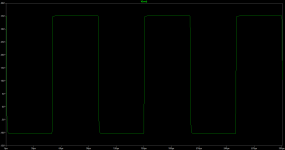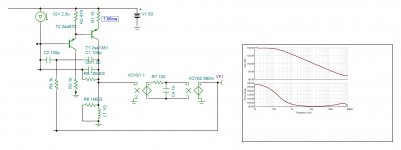Why to use 2 poles instead of one? On the contrary what people think , it has nothing to do with the stability, but the purpose is to widen the open loop bandwidth. Very grand majority of designers don't give any attention to this aspect, after all there are one thousand and one opamps with open loop bandwidth of few hertz and they have the reputation of excellence. So why to bother about open loop bandwidth?
The first aspect is to have a uniform NFB applied to the whole spectrum, same treatment to all 20-20khz without segregation.
The second aspect comes from tube amplifiers. In Williamson for example the OL bandwidth is 10khz limited by the OPT, 20db NFB is applied . With large OL bandwidth , on the transient of the input burst , the phase starts nearly what it will be on steady state . Whereas in very low OL bandwidth , it starts with -90° phase shift to reach gradually to that of steady state. This phenomena , provokes transient distortion if multiple voices burst at same time interval. To hear what I mean ,listen with a low OL the requiem of Verdi YouTube . With my aging ears I can clearly hear enhancement to 30khz OL bandwidth my be a sensation to 40Khz but above I don't think is necessary , but if can why not.
The VAS circuit that will be submitted to all kinds of 2 pole compensation techniques has OL bandwidth of about 4khz, to widen it to at least 20khz.

There are four different types of 2 pole compensation I found . TPC,TMC,Cherry NDFL and dadod's OIPTC. I will try all of them , and evaluate comparatively.
If you have suggestions to try out this or that , please be welcomed .
Hayk
The first aspect is to have a uniform NFB applied to the whole spectrum, same treatment to all 20-20khz without segregation.
The second aspect comes from tube amplifiers. In Williamson for example the OL bandwidth is 10khz limited by the OPT, 20db NFB is applied . With large OL bandwidth , on the transient of the input burst , the phase starts nearly what it will be on steady state . Whereas in very low OL bandwidth , it starts with -90° phase shift to reach gradually to that of steady state. This phenomena , provokes transient distortion if multiple voices burst at same time interval. To hear what I mean ,listen with a low OL the requiem of Verdi YouTube . With my aging ears I can clearly hear enhancement to 30khz OL bandwidth my be a sensation to 40Khz but above I don't think is necessary , but if can why not.
The VAS circuit that will be submitted to all kinds of 2 pole compensation techniques has OL bandwidth of about 4khz, to widen it to at least 20khz.
There are four different types of 2 pole compensation I found . TPC,TMC,Cherry NDFL and dadod's OIPTC. I will try all of them , and evaluate comparatively.
If you have suggestions to try out this or that , please be welcomed .
Hayk
Attachments
Last edited:
TMIC looks to be 1 pole . How does it extend the bandwidth. The literature you propose to bimo, is Bob cordell book TPC and TMC. If you are the author can you as dadod for his OITPC give instructions how to conceive.
Following the instructions/formulae given by Harry Dymond & Phil Mellor in AES Convention paper Nov. 2010 , I could very easily obtained 50khz bandwidth with identical high frequency character.

C2 adjusts the Dominant pole C4 adjusts the high frequency audio band cut 50khz, R7 adjusts the knee , the Q, if you prefer. The phase margin is 30° only at 300khz . If the fc is 20khz the phase margine is about 50°.
Hayk
C2 adjusts the Dominant pole C4 adjusts the high frequency audio band cut 50khz, R7 adjusts the knee , the Q, if you prefer. The phase margin is 30° only at 300khz . If the fc is 20khz the phase margine is about 50°.
Hayk
Attachments
Last edited:
Hi Hayk,
I follow your threads, very interesting, but as I don't use Tina it's hard for me.
I started to use LTspice not so long ago and never used any other spice software before. LTspice is quite intuitive with good help page, and most people here use it.
I am quite sure you could start with it easily.
Best wishes, Damir
I follow your threads, very interesting, but as I don't use Tina it's hard for me.
I started to use LTspice not so long ago and never used any other spice software before. LTspice is quite intuitive with good help page, and most people here use it.
I am quite sure you could start with it easily.
Best wishes, Damir
"MIC can be combined with TMC to reap the advantages of both techniques. The TMC network is merely returned to the input of the IPS instead of the VAS." BC
Last edited:
The TMC?
I couldn't find any good engineering explanation of TMC . The Baxandal paper says this

From dadod TMC or TPC my dilemma resolved? I found how to transform from TPC to TMC. What a jock???.

I will study this circuit in my own way , according to it's principal ,I see what can obtain.
I couldn't find any good engineering explanation of TMC . The Baxandal paper says this
From dadod TMC or TPC my dilemma resolved? I found how to transform from TPC to TMC. What a jock???.
I will study this circuit in my own way , according to it's principal ,I see what can obtain.
Attachments
"MIC can be combined with TMC to reap the advantages of both techniques. The TMC network is merely returned to the input of the IPS instead of the VAS." BC
I agree. TMIC is two pole because the loop gain has two pole.
But my favorite is OITPC, because the THD characteristic. In OITPC, more small level output voltage, more less THD. THD increase with level output.
Nice thread.
Let’s not argue about names.
Just do the work and then we can discuss the results.
I use 2 pole comp in some of my designs and you get >>20 dB distortion reduction at 20 kHz so it is a very useful technique for amplifier designers.
Let’s not argue about names.
Just do the work and then we can discuss the results.
I use 2 pole comp in some of my designs and you get >>20 dB distortion reduction at 20 kHz so it is a very useful technique for amplifier designers.
For me TMC is a single pole . Feedback large capacitor and the resistance bear nearly the same information, hence the capacitor is operand only for high frequencies that the output can't transmit including the output LR.
No doubt you can go faster by writing 16v Turbo GTI on your bicycle than making your amp TMC compensated.
If you feedback the compensation to the input , it doesn't extend the OL bandwidth.
No doubt you can go faster by writing 16v Turbo GTI on your bicycle than making your amp TMC compensated.
If you feedback the compensation to the input , it doesn't extend the OL bandwidth.
What phase margin you get on minimum about 30khz? The bandwidth is about 1.5khz how much it becomes if you bring the phase margin of 30° ? Just to compare with TPC. Do you think I can have any hope to bring the OL bandwidth 50khz?
Last edited:
For me TMC is a single pole . Feedback large capacitor and the resistance bear nearly the same information, hence the capacitor is operand only for high frequencies that the output can't transmit including the output LR.
No doubt you can go faster by writing 16v Turbo GTI on your bicycle than making your amp TMC compensated.
If you feedback the compensation to the input , it doesn't extend the OL bandwidth.
TMC is two pole compensation. Look here: https://www.diyaudio.com/forums/solid-state/182554-thermaltrak-tmc-amp-3.html#post2643498
Last edited:
Tomorrow , I simulate your VAS , and see where is the error. For me the 1K R30 is in parallel to C6 100pf except at high frequencies. I doubt about serial generator open loop measurement.
Tomorrow , I simulate your VAS , and see where is the error. For me the 1K R30 is in parallel to C6 100pf except at high frequencies. I doubt about serial generator open loop measurement.
The same result you will get with Tian probe.
You can find more thread about TMC here in this forum. It is even patented.
The same result you will get with Tian probe.
You can find more thread about TMC here in this forum. It is even patented.
In 80's , 4000 patents were deposited each year in France, 2000 of them concerned perpetual movement.
In 80's , 4000 patents were deposited each year in France, 2000 of them concerned perpetual movement.
OK. I am out of this thread.
OK guys, we have gone over if TMC is a two or one pole compensation before. This is the conclusion:
- From the perspective of the input stage and the overall open loop of the amplifier (AOL), TMC is single pole. It is essentially a Miller compensation (single pole) that at lower freq. is wrapped around the second stage and OPS, and a higher frequency is wrapped around the second stage only.
- From the perspective of the OPS, it is 2 pole. This is a lot more difficult to see intuitively. I'll post an intuitive explanation once I come up with one. In the meantime, attached is an analysis I hand-wrote some time ago.
Enjoy!
- From the perspective of the input stage and the overall open loop of the amplifier (AOL), TMC is single pole. It is essentially a Miller compensation (single pole) that at lower freq. is wrapped around the second stage and OPS, and a higher frequency is wrapped around the second stage only.
- From the perspective of the OPS, it is 2 pole. This is a lot more difficult to see intuitively. I'll post an intuitive explanation once I come up with one. In the meantime, attached is an analysis I hand-wrote some time ago.
Enjoy!
Attachments
Damir, where is the second pole? For your measurement, you are breaking the loop before the 1k R30 VAS feedback. The VAS feedback makes part of the open loop function. The series generator must be inserted after R30.
I feel sorry you are out of this thread. And I thought Damir means , strong as iron in Turkish. You are always welcome back.
Attachments
Last edited:
- Home
- Amplifiers
- Solid State
- Comparison Of 2 Pole Compensations









